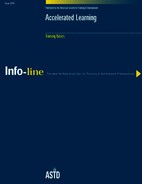A Tool for Training
When we consider the future forces in training and human resource development, accelerated learning offers a viable training approach that offers the following benefits:
Maximizes Time Spent Training
More can be learned during the training session, which improves performance on the job. This demonstrates the value of training.
Addresses Accelerated Change
By responding in kind and by decreasing barriers to learning and change, this approach creates a learner who is more responsive to continuous training. Increasing success in the classroom increases success on the job.
Integrates Learning Tools and Technologies
It is an organized smorgasbord of learning techniques, providing variety within a proven methodology.
Accommodates Different Learning Styles
By emphasizing multimodality instruction, this approach reaches out and stimulates the senses within individual preferences.
Develops Creativity in Trainers and Learners
It is more fun to train with a tool bag of creative, stimulating learning techniques. Learners experience creative insights through a provocative program and are more willing to experiment and explore within a supportive and empowering environment.
Develops Systems Thinking
This is promoted by emphasizing the larger picture, by creating links between existing and new ideas, and by forming new associations within an existing framework.
The information age demands continuous learning through training programs that maximize the learning process. Taking an accelerated learning approach can help trainers not only maximize learning time, but also maximize the learning potential of trainees. Through greater integration and retention, the principles and techniques of accelerated learning help address this training challenge. To examine changing training trends, see the sidebar on the next page.
Training TrendsThe trends in training from the Industrial Age to the Information Age reflect the development in education philosophy based upon a greater understanding of the human learning process:
|
Removing the Learning Barriers
The word accelerative refers to the rate of acquisition in terms of maximizing learning ability in time. Accelerated learning is concerned not only with time, but also with effectiveness. Researchers have found that people learn more effectively in a positive, emotionally supportive learning environment. In the words of one advocate, “the basic idea is to take stress and competition out of the classroom and replace it with positive energy and collaboration.”
One of the challenges of training is to “get out of the way” of learning. According to Eric Jensen, an expert in accelerated learning, “The brain's natural function is to learn quickly and easily…accelerated learning consists of removing the barriers to learning and addressing the obsolete learning conditions…to orchestrate the input in a way that is playful, multimodal, relaxed, positive, consistent and congruent.” An accelerated learning approach to training creates and manages the conditions that facilitate learning and applies techniques to reduce the barriers that impede learning. Through techniques such as games, music, and suggestions, it creates a lively yet relaxed learning atmosphere and emphasizes whole-brain learning in a positive and consistent manner.
Are the techniques of accelerated learning new? Several of the techniques have been used for years, although not in a consistent or deliberate way. We now have an understanding of why they work and how best to use them. What is different about this approach is the consistency and sequence of preparation, presentation, and involvement of learners and its focused engagement of the nonconscious mind.
This issue of Info-line will look first at the principles and techniques of accelerated learning, then organize them in a model for creating an accelerated learning environment, and finally apply them in a sample accelerated learning course design.
